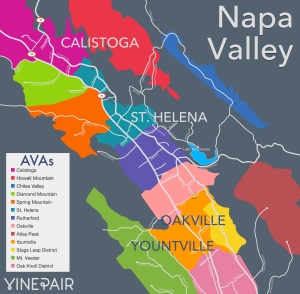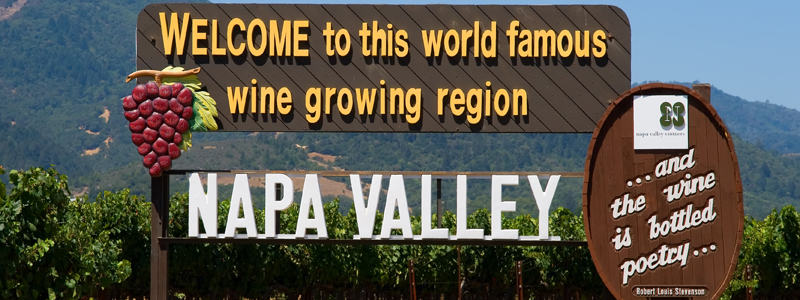Napa Valley. Two words that evoke a sense of elegance, luxury and lots and lots of high-end wine. Also, according to Twitter, the happiest place in the US. For many people, however, Napa merely means expensive wine, as opposed to good wine. It’s seen as a marketing gimmick, designed to convince us that the wine in Bottle A is somehow worth twice as much as Bottle B. But if most of us can’t tell the difference between bottles A and B, why should we care about Napa? Well, for one thing, Napa is the original home of great wine in North America, and, I would argue, the region turning out the most consistently high-quality wine in the country.
But what exactly is it that makes Napa so special? Are the wines really better than other regions in California, or the rest of the world? Are they worth the extra cash? The answer – or at least my answer – is yes.
Understanding The Land
First, let’s take a look at what makes Napa so unique. In my opinion, the most important aspect is Napa’s “terroir,” meaning the combination of climate, soil and terrain. Great wine is made in the vineyard, not the cellar. So, fundamentally, the way to make great wine is to be a great farmer. And to be a great farmer, you need great terroir. The terroir of Napa offers ample opportunity for both farmers and winemakers to succeed.

There are a number of reasons why Napa is ideally suited to growing grapes – and many other crops. Indeed, the word Napa literally means “land of plenty” in the language of the Wappo Indians, who first named the region. It is one of very few places in the world to enjoy a “Mediterranean climate,” which basically means the summers are very warm, the winters are mild and it only rains between November and February. This gives the vines a very long growing season, as spring frosts (which can kill off young grapes) and fall rains (which can lead to mold) are less of a threat. Second, the low temperatures at night vary dramatically from the highs during the day, with up to 40 degrees Fahrenheit difference. The warm days allow the grapes to ripen and develop flavor and sugars (which later get fermented into alcohol), while the cool nights allow the vines to rest and keep acid levels up. These three things – sugar, fruit and acid – create wines that are balanced and nuanced.
For many of us, acid is not necessarily something we think about when we consider wine. But it applies to wine just like it applies to food. For example, to liven up a piece of fish or chicken, you might add a spritz of lemon. When you’re making lemonade, you want to add just enough sugar to bring out the lemon flavor and temper the acid, but not so much that it becomes cloying. The same is true of wine: you need acidity there to keep things fresh and enhance the flavors.
The soils in Napa are also incredibly complex, with over 100 types of soil, or about ½ the soil types that exist on the planet Earth, present. Much of it is volcanic. These soils create many unique pockets all over the Valley, which, combined with varying temperatures, sun exposure, altitudes, etc. create myriad conditions for growing different kinds of grapes and making different kinds of wine.
In terms of what grapes do best in Napa, Cabernet Sauvignon is the undisputed king of the Valley. The warm, long growing season is especially conducive to this native-Bordeaux grape and its blendable cousins Cabernet Franc, Merlot, Malbec and Petit Verdot. So-called “Bordeaux blends” including all five of these grapes are the calling card of the region. Sauvignon Blanc, the backbone of white Bordeaux, also thrives in Napa, along with Zinfandel and Syrah. Some wineries make great Chardonnay as well, though in my opinion most of the Valley is too warm for this cooler-climate grape to really shine.
A History Lesson
The next piece of the Napa puzzle is its rich history. In 1861, a Hungarian Count brought over 100,000 vine cuttings from Europe to plant in California. Then in 1900, a Frenchman named Georges de la Tour arrived in Napa and decided to plant grapes from his native Bordeaux. His wife, upon arrival, exclaimed about the beauty of the place, and thus gave their winery its name, Beaulieu, which means beautiful place in French. Beaulieu Vineyards still exists today and is one of Napa’s most iconic wineries. This and other early wineries laid the foundation for making high-quality wines and were pioneers in experimenting with what grapes, farming and winemaking practices worked, and didn’t work.
Despite this early start, recognition did not really come to Napa until the 1980s. Up until the late 1970s it was still a backwater agricultural community where you were just as likely to see orchards of walnut trees as vineyards. The turning point was the Judgment of Paris in 1976 when two California wines, a Cabernet Sauvignon and a Chardonnay, were voted #1 in a blind tasting against some of the great French wines – by French wine experts. After that, interest in Napa’s wine industry skyrocketed. Tourists flocked to the region to discover its wines, and many more wineries sprung up along Highway 29, the main road that cuts through the Valley from north to south. The accompanying influx of capital allowed wineries to invest in better equipment, vineyards and people and to refine winemaking and vineyard techniques. In some cases, however, more money meant less focus on quality and more focus on wine as a commodity. Large corporations also got into the game, buying up historic properties like Beaulieu (now owned by Diageo) and Robert Mondavi (owned by Constellation, the largest wine company in the world).
This means that in Napa, just like in any other major world wine region, there is a lot of variation. There are wineries who produce incredibly high-quality wines, and there are those who don’t. It all comes back to knowing your producer.
Also like other famous wine regions (I’m looking at you Burgundy and Bordeaux), there are extremely expensive wines coming out of Napa. Is it just price gouging? Can a bottle of wine really be “worth” $150, $300, $800?
This opens up a whole different can of worms (and is a post in and of itself) about what goes into a bottle of wine. For our purposes, consider that, just like great artisanal food producers, great winemakers put a lot of care into every step of the process, from farming, to wine processing, to aging, to bottling. To do it well costs money. Whether it’s “worth it” is a matter of personal opinion. In my personal opinion, it is.
That being said, if you’re looking for a $15 bottle of wine, Napa is not the right place for you. At that price point, I would look to Alsace, the Loire Valley, southern Italy or California’s Central Coast. But if you’re willing and able to spend a little more, Napa offers a treasure trove of delicious wines made by passionate, extremely skilled people. Here are a few of my favorites to get you started:
Off the beaten path: Shypoke
Peter Heitz, a fourth generation “Napkin” (Napa native), makes small lots of wine out of his garage in Calistoga. One of his vineyards dates from 1904. He makes Cabernet Sauvignon, Napa’s calling card wine, but also has some fun, obscure varieties like Sangiovese, Charbono and Petite Sirah. The wines are hard to find in a retail shop, but you can buy them online here.
Napa Classics: Grgich Hills Estate
One of the “big guys” who’s been around since the ‘70s, Mike Grgich actually made the winning Chardonnay in the Judgment of Paris when he worked at Chateau Montelena. Grgich still makes European-inspired style wines including Chardonnay, Sauvignon Blanc, Merlot, Zinfandel and Cabernet Sauvignon. They are more widely distributed and easy to find, but you can buy straight from the winery on their website.
Great Budget Bordeaux Blend: Bridesmaid
The grapes in this wine are the “bridesmaids” rather than the bride, and for the price, it’s a fantastic deal. If you aren’t quite ready to spring for the super premium bottles below, this is a great alternative that will appeal to both your tastebuds and your wallet. You can buy Bridesmaid wines here.
Super premium Cabernet Sauvignon: Corison Winery or Anomaly
For about $80, both of these wineries deliver delicious and distinctive Cabernet Sauvignon. Cathy Corison has been making wine for decades and it shows in her phenomenal product. Anomaly is a relative newcomer, a product of “accidental vintners” who bought a house with some vines on it and decided to make wine in their garage. It was so good, now they make wine on purpose.
Header image via Shutterstock.com
Adrienne is a native New Yorker who now lives in Napa with a penchant for all things food & beverage. Previously she co-founded Dipsology, a guide to great cocktails in NYC, and she is also a Certified Sommelier. Follow her on twitter @alstillman.

